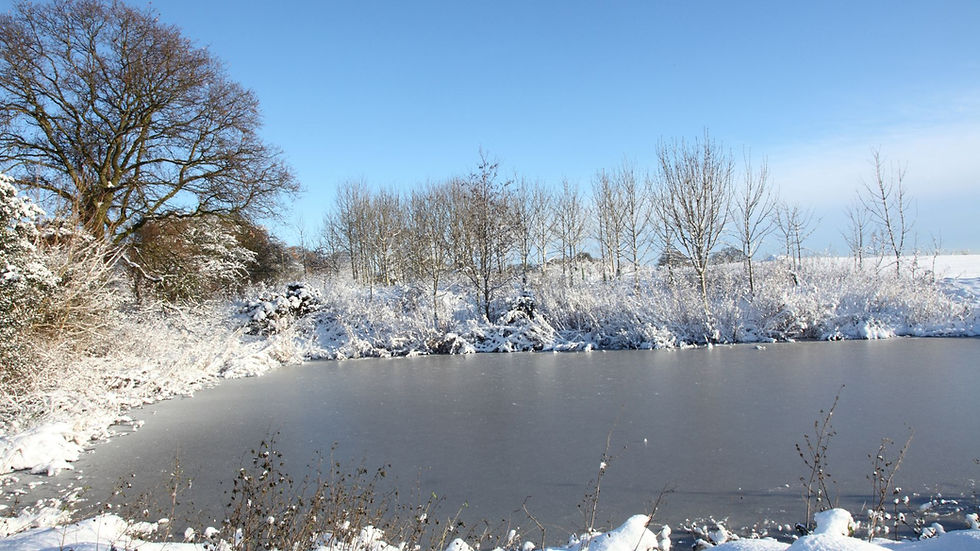The Importance of Plants in a Pond Ecosystem
- Richard Fulford

- Jan 31, 2023
- 4 min read
Learn about the Vital Role of Plants in a Pond Ecosystem

Creating a beautiful and healthy pond ecosystem requires a delicate balance of different elements, and one of the most critical elements is plant life. Not only do plants add visual interest and aesthetic appeal to your pond, but they also play a vital role in maintaining the overall health of your garden oasis.
In this blog, we will explore the importance of plant life in a pond ecosystem and how including different types of plants can help create a balanced and thriving aquatic environment.
From the role of submerged aquatic plants in oxygenating the water to the importance of floating and marginal plants for providing habitats and breeding grounds for a variety of aquatic wildlife, we will delve into the many benefits plants can bring to your pond.
Whether you're a pond enthusiast looking to create a beautiful and functional ecosystem or want to learn more about the role of plants in aquatic environments, this blog is for you.
Table of Contents:
1. Plants in a pond ecosystem - Groups of Water Plants - Introduction.
Having a variety of plants in your pond is essential for creating a balanced and healthy ecosystem. Plants act as natural filters for your pond, absorbing excess nutrients and pollutants from the water. This helps to keep the water clean and clear, promoting a healthy environment for fish and other aquatic life.
Additionally, plants provide essential habitats for various aquatic creatures, such as insects, amphibians, and small fish. According to the position in the pond, there are five main groups of water plants: submerged plants, floating plants, marginal plants, bog plants and deep-water plants.
2. Submerged Pond Plants.
Submerged pond plants grow up from the bottom of a pond, and their foliage can break up the water's surface. These plants are known as oxygenators. They play a vital role in a pond ecosystem, as they maintain the balance and health of the aquatic environment by providing oxygen, shade and helping to control algae growth.
One of the most critical functions of submerged pond plants is oxygenation. By absorbing carbon dioxide and releasing oxygen, they create a healthy environment for fish and other aquatic life. Additionally, submerged plants help to control the growth of algae by absorbing excess nutrients from the water.
Submerged pond plants also provide important habitats for a variety of aquatic creatures. They serve as a breeding ground and shelter for insects, amphibians, and small fish. Some species of fish also feed on submerged plants, helping to control their population and maintain the balance of the ecosystem. Popular types of submerged pond plants include Water Buttercup, Hornwort, and Willow Moss.
3. Floating Pond Plants.
Floating Pond Plants have submerged roots, but their leaves float on the water's surface or just below it. One of the essential functions of floating pond plants is to bring shade and shelter for fish. They act as a natural sunscreen, reducing the direct sunlight penetrating the water, which can help prevent overheating and stress on fish. Additionally, floating plants help to control the growth of algae by absorbing excess nutrients from the water.
Floating pond plants also provide important habitats for a variety of aquatic creatures. Some species of fish feed on floating plants, helping to control their population and maintain the balance of the ecosystem.
Popular floating pond plants include Water Solider, Frogbit, and Water Chestnut.
4. Marginal Pond Plants.
Marginal pond plants, also known as edge or bog plants, are an essential part of a pond ecosystem. These plants are typically found along the edge or shallows of a pond (50-150mm) and provide various benefits for the overall health and balance of the ecosystem. Some are fine with roots in water, and others prefer a little soil.
One of the important functions of marginal pond plants is to provide a natural filtration system for the water. They absorb excess nutrients and pollutants, helping to keep the water clean and clear. Additionally, they help reduce the amount of erosion on the pond's edge.
Marginal pond plants also create habitats for a variety of aquatic creatures.
Popular marginal pond plants include Arrowhead, Blue Flag Iris, and Bog Arum.
5. Deep-water Pond Plants.
Deep-water pond plants are typically found in deeper parts of a pond and are essential for the overall health and balance of a pond ecosystem. They absorb carbon dioxide and release oxygen, creating a healthy environment for fish and other aquatic life. Additionally, deep-water plants help control algae's growth by absorbing excess nutrients from the water.
With their roots growing in the bottom of the pond, these plants absorb up waste products produced by fish. Their floating leaves can provide a good shade if they cover about a third of the pond's surface.
Popular types of deep-water pond plants include Water Hawthorn and Water Lilies. They are suitable for a pond at least 300mm deep.
6. Summary.
In conclusion, plant life in your pond ecosystem is essential for maintaining a balanced and healthy environment. Not only do plants act as natural filters, but they also provide crucial habitats and breeding grounds for a variety of aquatic wildlife. Additionally, the visual interest and aesthetic appeal that plants add to your pond make them valuable to any aquatic environment.
Do you need help?
If you're a pond owner and want to create a healthy and balanced ecosystem in your pond, it's important to have the right mix of plants and the correct ratio of plants to fish and other aquatic life. Achieving this balance can be challenging, but with the help of a pond specialist, you can create a beautiful and functional ecosystem that will thrive for years to come.
Get in touch with FishLife - your local pond specialist operating across Surrey, Sussex, Hampshire, Berkshire and Wiltshire with expertise and experience to help you choose the right types of plants for your specific ecosystem, and can provide valuable advice on how to maintain the correct balance for a thriving aquatic environment.





Comments